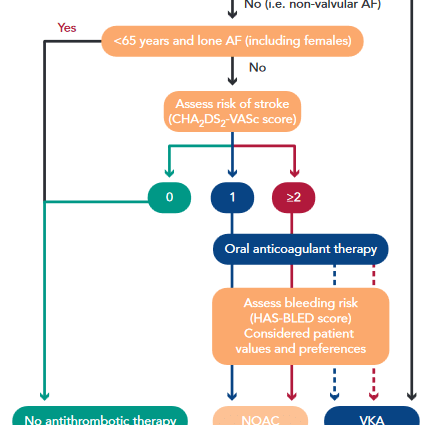In line with its mission, the Editorial Board of MedTvoiLokony makes every effort to provide reliable medical content supported by the latest scientific knowledge. The additional flag “Checked Content” indicates that the article has been reviewed by or written directly by a physician. This two-step verification: a medical journalist and a doctor allows us to provide the highest quality content in line with current medical knowledge.
Our commitment in this area has been appreciated, among others, by by the Association of Journalists for Health, which awarded the Editorial Board of MedTvoiLokony with the honorary title of the Great Educator.
Modern medicine offers patients with atrial fibrillation more and more modern drugs to prevent the formation of blood clots causing stroke.
Already at the beginning of the last century in Vienna, Carl J. Rothberger and Heinrich Winterberg and Sir Thomas Lewis in London independently made the first-ever electrocardiographic record of atrial fibrillation. Since then, the knowledge of this condition has expanded significantly. Currently, various treatment strategies are assumed, depending on the specificity of atrial fibrillation, its severity, but above all, on the patient’s susceptibility to a given type of therapy.
Beginning of anticoagulant therapy
During fibrillation, the atriums of the heart stop contracting regularly and begin to tremble. This condition causes blood flow problems and an increased risk of blood clots forming. Sometimes a fragment of it breaks off, which can flow towards the brain with the flow of blood and cause clogging of the vessel supplying the blood there, resulting in a stroke. Therefore, patients with atrial fibrillation are given anticoagulants. Knowledge on this subject was provided only by large studies conducted in 1989–1992. It was shown then that in patients treated with the anticoagulant drug – warfarin, compared to patients without treatment, the risk of stroke is lower by approximately 70%. Since then, attention has been drawn to the significant role of anticoagulant therapy in preventing complications of atrial fibrillation, among which ischemic stroke is the most common and dangerous. The action of warfarin was also compared to that of acetylsalicylic acid and clopidogrel. Studies have shown a much better effect of warfarin in preventing stroke and other episodes of embolism.
Despite its positive properties, warfarin, which prevents blood from clotting, increases the risk of major bleeding, however. In addition, the effects of warfarin in a patient are influenced not only by genetics and other medications used, but also by the products he consumes. Therefore, constant control of blood coagulation became necessary and, depending on this, modification of the drug dosage.
What’s new in anticoagulant therapy
Recently, research has been started on a new type of anticoagulants, which, due to their ease of use and effectiveness comparable to warfarin, may replace it in the near future. Taking these drugs does not require constant monitoring of blood clotting. The drugs apixaban, rivaroxoban and dabigartan belong to the new class. According to the latest research, a breakthrough in antithrombotic treatment is currently taking place. They found that the new drugs could effectively replace warfarin in patients with persistent atrial fibrillation taking it. Tens of thousands of atrial fibrillation patients with additional risk factors for stroke have participated in large studies. The results of treatment of patients taking warfarin were compared with those treated with new drugs (rivaroxaban, dabigatran). The experiments lasted for several years. Their results showed that there was a reduction in stroke or systemic embolism, episodes of major bleeding and death in the group taking the new drugs compared to the group receiving warfarin.
Medical consultation: dr Radosław Sierpiński, Heart for Arrhythmia Foundation










